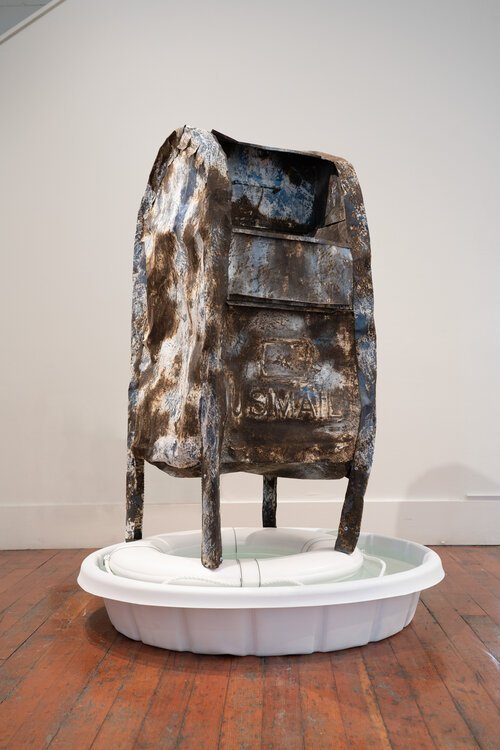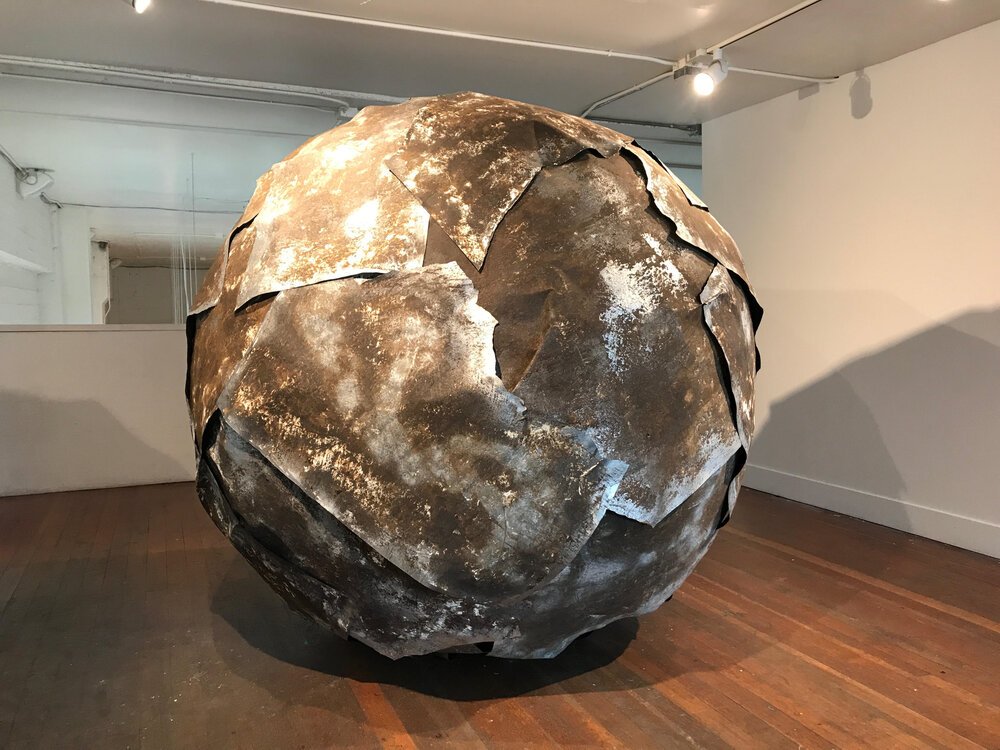20191116 Rafael Bustillo interview
Rafael Bustillos was born and raised in Culiacan, Sinaloa, Mexico. In May of 2018, Rafael obtained a MFA from the San Francisco Art Institute. While his time at SFAI, Rafael created work with photography, ceramics, and paintings. He is currently making painting and sculptures by using utilitarian material that are commonly used to build homes.
Kacy (K): Hi Rafael, thank you so much for being here! How would you describe your art to someone who doesn't know you yet?
Rafael (R): I like to talk about a social concept through a philosophical approach. Take how humanity is leaving the planet, for instance. I enjoy discovering things by asking questions. A question usually leads to another. I explore the connection between creation and destruction and how humans participate or accelerate this process without knowing that we're creating new things nor we're destroying something.
K: Can you elaborate a bit more about how do you approach this process to create your visual work, more specifically?
R: To begin with, this is a multi-layered process. The first step is to make something that appears heavy but actually isn't. It is the use of optical illusions to deceive the viewers. The next step is to give the viewers' minds enough time to process questions. What is that material? How is something so heavy here? The mind is processing in many overlapping layers as we try to identify something, but we're not aware of it. Our awareness was limited to the present, but the subconscious was already processing far more information than we were aware of.
K: Can you tell me a little bit about how you developed as an artist to the point where you are now?
R: I remember from a very, very early age, I was always creating things, making pyramids, or making things with Lagos. Although I did not know the purpose, I was always interested in transforming things. And when I was in high school, I was exposed to photography, the process of photography, and how they develop the photos in the darkroom room as an intern. But I wasn't really practicing. I was more observing. Then I got into a construction field outside of my college study. I was working for a company, artistic-based construction such as a fake European style fireplace like the one you will see in an old castle. I graduated with a degree in Psychology. After my graduation, I started practicing as a therapist. First, I worked at Planned Parenthood, a place mainly for women with issues of depression, anxiety, and panic attacks. Then I started working with families. When I was working with families, I felt that I could be more productive working with children. During that time, I was doing a lot of black and white photography outside of my job. One person she asked me to show my work at the San Francisco Art Institute. I did, and that's why later on, I did a one-year post-baccalaureate and then a two-year MFA at the SFAI.
K: May I ask why did you not pursue art full time earlier but at that time? Was something that happened that made you make the switch?
R: I wasn't thinking about doing art full time in the beginning. It is because I have never had any art mentors before. So I do not know how to validate my creativity. I wasn't thinking about going to art school because I wanted to be a father and raise a family. I wanted to have a job that will give me that opportunity in life. I felt that art wouldn't be able to provide me with financial stability. I like it a lot in psychology. I found it a good fit for me because I was learning, helping, and financially secure. But as a therapist, I experienced some very challenging moments and times. There was a conflict between the essence of being a therapist versus the bureaucratic aspect of being a therapist.
I learned that it was a completely polarize subjective. The research of psychology is so strong, and there's so much to do around the theories, the research methodology, etc. However, when you want to practice, some things might get in the way that doesn't allow you to put everything into practice, which is the political or social aspects as well. For instance, being a Mexican male in the therapists' work was very challenging because this is a field that is very much populated with females. Also, there is something that happens in any field where you're going to face competitions and challenges. And at the same time, one of my kids, one of the kids I was treating, committed suicide. This nine-year-old kid was not only magical for my learning curve as a therapist but also as a human being. That was a wake-up call, thinking that I needed to do something versus being married to my professional. So when that happened, I started reflecting on what he said about me that was no balance. So then I began to make more art and going to art school. Be part of the community and start developing myself as a professional artist.
K: Art making is such a powerful healing process……
R: I don't know if I can call it healing, but it's like because I ever since I was a kid, I'm the kind of person who is constantly thinking, analyzing, and trying to understand life and the way we function in this world. So for me, art is a fantastic outlet to have a conversation not only with myself but with the world. Making things, seeing how things can be transformed, seeing how things can speak to people, seeing how other people can connect with things I make is very helpful for me to be the way that I am. This is a very satisfying process.
K: A lot of people mistake having a stable life grants a happy life. But this is not the case for everyone. From my perspective of how society works, so many people don't seem to work for themselves but rather work to keep this capitalist system active. When I look back, I realized how important the idea of "profit-driven" affected my decision-making. Do you have anything you want to talk about how the current profit-driven system affects your art journey?
R: Well, it is impossible to separate from the system. I have to buy all my supplies, and it's just an example of how we connect to it in our everyday life. And nowadays, we assemble as an artist, and I want to make work that can be sold. Of course, there's a giant ladder to climb for that. I would love to see people buying my stuff, and I can make a living from that. But I know that is a long way to go. Meanwhile, I want to continue research in my theory and the purpose of my art-making. I'm really excited to see where it will take me without having to have a second job. And have that be said if I have to answer how capitalism affects my journey is by the fact that I am still married to capitalism because I need to make money to make a living.
K: These are some great points, Rafael. I am also thinking about the idea of making a living and making a profit, making artworks, and making commodities. I would never expect an environmental activist who cares about carbon footprint to stop breathing, but art-making seems to be more complicated than that. Thank you so much for sharing your experience with me. I really enjoyed our conversation!


